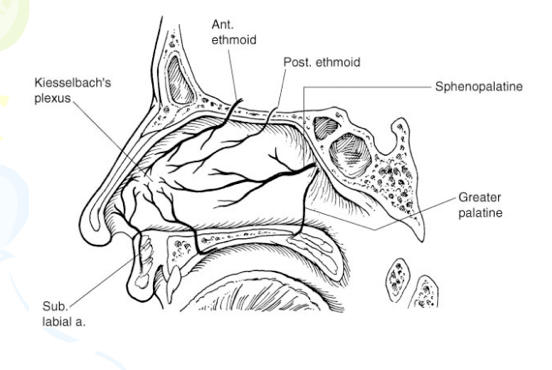The rich blood supply to the nasal region predisposes individuals to epistaxis in nasal trauma. Epistaxis can be categorized as anterior or posterior, depending on the source of bleeding. The most common location is anterior epistaxis, originating from Kiesselbach’s plexus in the anteroinferior septum, which receives its blood supply from both internal and external carotid arteries. Posterior epistaxis typically arises from branches of both the sphenopalatine and anterior ethmoidal arteries. It is less common than anterior bleeding but a more frequent cause of severe hemorrhage. Nasal hemorrhage can usually be controlled by direct manual pressure in anterior bleeds. Hemorrhage from posterior sources usually resolves spontaneously, particularly if the patient’s blood pressure is controlled. However, in persistent cases, posterior packing or Foley balloon catheterization of the nasal passage may be necessary. In the most severe cases, usually secondary to maxillary arterial sources, interventional embolization may be required. Both the ophthalmic and maxillary divisions of the trigeminal nerve supply sensation to the nose. The infratrochlear nerve provides sensation to the skin of the upper nasal dorsum and sidewalls, and the anterior ethmoidal supplies the lower dorsum and tip.
skip to main |
skip to sidebar
Daily, Monthly, Yearly
The longest journey begins with the first step,
Step by Step.
Search
Follow
RECENT POST
Labels
- Adrenal insufficiency (1)
- airway obstruction (1)
- alveoli (1)
- Ameloblastoma (1)
- antibiotic (1)
- antibiotic prophylaxis (1)
- anticoagulant (1)
- antiplatelet (2)
- ASA (1)
- autoregulation (1)
- Bilateral sagittal split osteotomy (1)
- bilirubin (1)
- biopsy (1)
- Bisphosphonate induce osteonecrosis (1)
- book (1)
- Brain injury (1)
- Brown sequard syndrome (1)
- BSSO (1)
- CA metastasis node (1)
- Calcium channel blocker (1)
- cancer (1)
- CBF (1)
- Chronic renal failure (1)
- Cocaine (1)
- conjugated (1)
- Coronectomy (1)
- COX-1 (1)
- COX-2 (1)
- danzen (1)
- deep temporlais fascia (1)
- dental consideration (4)
- dental extraction (1)
- diabetes mellitus drug (3)
- diabtes ketoacidosis (1)
- DM drug (1)
- dual antiplatelet (1)
- erytholeukoplakia (1)
- erythoplakia (1)
- Erythropoietin (1)
- Etomidate (1)
- extraction (1)
- facial fracture (3)
- facial nerve (1)
- Fibrous dysplasia (1)
- fracture mandible (1)
- Frontal sinus (1)
- Giant cell tumor of the jaw (1)
- HBO (1)
- Hemangioma (1)
- Hemostatic agent (1)
- HPA (1)
- Hypertension (1)
- Hyperventilation (1)
- Hypoventilation (1)
- IHD (1)
- impaction (1)
- IV anesthetic agent (1)
- Ketamine (1)
- lacrimal canaliculi injury (1)
- lateral pterygoid muscle (1)
- lefort I osteotomy (1)
- left shift (1)
- leukoplakia (1)
- liver disease (1)
- Local anesthesia (1)
- localized (1)
- lung (1)
- madibular fracture (3)
- MAP (1)
- maxillary fracture (2)
- Maxillary sinus (1)
- Melanin (1)
- Melanin stimulating hormone (1)
- Melanocyte (1)
- Monoclonal antibody (1)
- multiple myeloma (1)
- nasal bone fracture (3)
- nerve injury (2)
- NSAID (1)
- oculocardiac reflex (1)
- oral and maxillo facial surgery (1)
- oral and maxillofacial sugery book (2)
- oral lesion (1)
- Ossifying fibroma (1)
- osteoradionecrosis (3)
- Oxygen affinity (1)
- oxygen dissociation curve (1)
- Peterson (1)
- pigmented (1)
- Plate system (1)
- plavix (1)
- Propofol (1)
- Radiograph (1)
- red lesion (1)
- Regular insulin (1)
- Right shift (1)
- seconary parathyroidism (1)
- serratiopeptidase (1)
- SLOB (1)
- Steroid (2)
- Stroke (1)
- superficial temporalis fascia (1)
- suture (1)
- tear lacrimal canaliculi (1)
- temporalis fascia (1)
- temporopariental fascia (1)
- Thiopental (1)
- Third molar (1)
- toot extraction (1)
- unconjugated (1)
- Vascular malformation (1)
- vasovagal syncope (1)
- ventilation (1)
- white lesion (1)
- x-ray (2)
- ฺsinusitis (1)
Post history
-
▼
2009
(27)
-
▼
February
(12)
- oculocardiac reflex
- Lefort I osteotomy video clip
- fracture mandible and airway obstruction
- ANATOMIC CONSIDERATIONS IN NASAL BONE FRACTURE PAR...
- ANATOMIC CONSIDERATIONS IN NASAL BONE FRACTURE PAR...
- temporal branch of facial nerve injury (danger zone)
- x-ray and fracture line part 2
- x-ray and fracture line
- What is osteoradionecrosis (ORN) ?
- Stage of Osteoradionecrosis -- ORN
- Tear lacrimal canaliculi injury
- CA node metastasis or not
-
▼
February
(12)
No comments:
Post a Comment